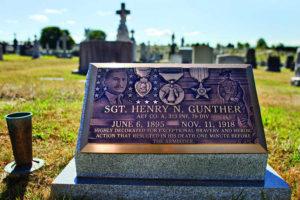From the files of the archdiocese and the Catholic Review – 1917-1918
Argonne, Belleau Wood, the Hindenburg Line.
The Official Diocesan Year Book for 1920 includes references to those prominent World War I locales over 12 pages under the heading, “List of the Catholic Boys From The Archdiocese Of Baltimore Who Made The Supreme Sacrifice in the World War.”
Three years after the conflict began in Europe, Americans were still debating entry into what, unfortunately, did not live up to its billing as the “War to End All Wars.” Nicholas Varga’s history of what is now Loyola University Maryland, “Baltimore’s Loyola, Loyola’s Baltimore,” notes that Herbert O’Conor, who quarterbacked the Greyhounds in football and would serve Maryland as governor and in the U.S. Senate, earned oratory recognition for his support of President Woodrow Wilson’s neutral position on entering the war.
The U.S. Congress voted to declare war on Germany April 6, 1917. Six weeks later, the Selective Service Act was enacted. Loyola College students voluntarily enlisted in droves, as did parishioners with families. According to the U.S. Foundation for the Commemoration of the World Wars, more than 62,000 Marylanders served in World War I; nearly 2,000 lost their lives.
That toll included 20 men from St. Stanislaus Kostka, the former Polish parish in Fells Point, among them Stanislaus Dabrowski. St. John the Evangelist in East Baltimore, which closed in 1966, mourned 13, mostly with Irish names, such as the Army’s Martin Kavanaugh. St. Mary, Star of the Sea in Federal Hill, lost 12 men, among them Army Engineer John Dressel. St. Peter in Westernport remembered five who died in battle, including Army Cpl. Timothy Albert O’Leary.
St. Mark in Catonsville mourned Army Sgt. Martin Doyle, of Company B, 301 Battalion. The 1920 Diocesan Year Book quotes a letter to Doyle’s sister from a Lt. E.F. Frost, which said his “gallantry on the Hindenburg Line cannot be too highly praised. His bravery and coolness at all times while under a terrible fire was a great help to the officer and men working with him.”
Father William J. McVeigh, who would live until 1952, was among the 12 priests of the archdiocese who served as chaplains. He ministered to the 11th Infantry, 5th Division in the Meuse-Argonne Offensive, the final, pivotal Allied push in autumn 1918.
The Diocesan Year Book notes that its list of those killed in the war was “From Information Received Up To Present Time, October, 1920.” It does not list any men from Sacred Heart of Jesus in Highlandtown, but in October 2013, the Catholic Review poignantly remembered one of them.
“One minute before the 11th hour of the 11th day of the 11th month of 1918 – the moment when an armistice took effect to end World War I – Henry Gunther was shot and killed near the French village of Chaumont-devant-Damvillers,” the Review reported. “The 23-year-old infantryman and parishioner of Sacred Heart of Jesus in Highlandtown became the last casualty of World War I, receiving the Distinguished Service Cross posthumously.
“Gunther’s remains were returned to Baltimore in 1923, and he was buried at Most Holy Redeemer Cemetery. A memorial plaque citing him as the last casualty of the war was erected Nov. 11, 2010.”

